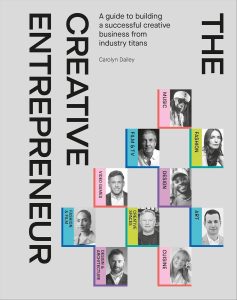
Book Review of The Creative Entrepreneur by Carolyn Dailey
Reviewed by: Emma Flack, Leadership Coach and Consultant, Tempo 76 Leadership Collective, LLC (www.tempo76.com)
The Creative Entrepreneur addresses how creatives can build thriving businesses while celebrating their artistic visions.
Carolyn Dailey’s guide for creative entrepreneurs comes alive in the untold stories of some of the world’s most celebrated innovators. She begins by offering perspective from her own decades of industry experience and defines how creative entrepreneurs are different from mainstream commercial business leaders.
To illustrate the opportunities and challenges at hand for creatives, Dailey organizes each creative entrepreneur case study around three pillars:
- Artist Interviews: These segments offer a first-person view on the creative entrepreneur’s career progression, strategies for growth, and stand-out moments.
- Takeaways: These are key, easy-to-skim lessons learned that were pivotal to the creative entrepreneur’s experience.
- Business Essentials: Each interview segment ends with a core business topic, with practical tools and steps for the reader’s application.
Dailey closes the book by exploring the impact and benefits of Generative AI, and offering a Future Outlook on the creative sector’s economic value and the integration of business education into creative disciplines.
When Nile Rodgers turned a few studio sessions into a global music empire, or when Priya Ahluwalia fused London streetwear with heritage textiles, they proved that artistry and enterprise can coexist. Yet, too many creatives still feel forced to pick one path or the other.
Carolyn Dailey’s The Creative Entrepreneur shatters that misconception, offering a hands‑on manual for building a thriving business while staying true to one’s muse. The book invites the reader to “pull up a chair to the dinner table” with industry titans from all walks of the creative realm. A dinner table where creativity and entrepreneurship must be explored as necessary partners, and not as ideals in competition with one another.
This visually stunning and inspiring work invites readers to explore the intersection of creativity and entrepreneurship. It features interviews with 10 industry trailblazers across music, fashion, design, TV, film, architecture, art, cuisine, and video games, including Nile Rodgers, Roksanda Ilinčić, Yinka Ilori, Andy Harries, Priya Ahluwalia, Thomas Heatherwick, Matthew Slotover, Ruthie Rogers, Strauss Zelnick, and Nick Jones.
Each shares their entrepreneurial journeys in such a way that teach and inspire creatives, who Dailey describes as those whose “life’s work is to build something beautiful for people to enjoy.”
The Good
The book excels in showcasing what is possible for creative individuals, encouraging them to chart their own path and hone their creativity.
Accessibility to Experts: Each creative is presented in a story that reads like a magazine feature article, blending powerful storytelling with conversational language that feels intimate and engaging. Not only does the reader gain a sense of the creative business of these successful leaders, but they also get a sense of their humanity through their “keeping it real” lessons of experience. Their boldness, vulnerabilities, failures, and career breakthrough points.
Playbook and Real Tools: The Business Essentials is a capstone that appears at the end of each interview, offering practical checklists and actionable advice on business imperatives like creating a business plan, building one’s brand, leveraging investors, managing intellectual property, selecting the right mentor, and many others. The inclusion of takeaways, templates, and practical advice ensures the book is not just inspirational but also highly useful for aspiring creative entrepreneurs.
Reading Experience: The layout feels like a high-end magazine, with vibrant photography, striking imagery, and mixed-media elements that immerse the reader into the creative entrepreneur’s world. This approach creates a sense of movement and energy throughout. The visual approach, combining editorial-style writing with personal quotes and insights, adds depth and variety to the reading experience. Each section is thoughtfully designed, with clean typography, colorful accents, and well-placed visuals that enhance the storytelling and make the content more accessible.
Common Themes: While some themes were specific to a particular artist’s experience, there were others which cross-pollinated over different artist experiences and industries:
- Follow Your Instincts: Many artists emphasized the importance of trusting their gut and pursuing their unique vision, even when it went against conventional wisdom or industry norms.
- Collaboration is Key: Building strong relationships and working with trusted collaborators was a recurring theme, as it often led to creative breakthroughs and business success.
- Adaptability and Resilience: The ability to pivot, learn from failures, and persevere through challenges was highlighted as essential for long-term success in creative entrepreneurship.
- Balance Creativity with Commerce: While creativity is the driving force, understanding the business side, such as budgeting, marketing, and intellectual property, is crucial to sustaining and scaling a creative enterprise.
- Start Small and Grow Gradually: Many artists advocated for starting with manageable goals, keeping overheads low, and scaling thoughtfully to avoid overextending resources.
- Stay True to Your Values: Maintaining authenticity and aligning business decisions with personal and brand values was a common thread, ensuring that their work remained meaningful and impactful.
The Bad
While the book is rich in storytelling and visually captivating, its editorial style may not appeal to readers looking for a more structured or academic approach to entrepreneurship. The use of varied layouts for each featured artist gives the book a fresh, editorial feel. However, the approach might feel overwhelming to readers who prefer or need a more streamlined presentation of information.
Conclusion
The Creative Entrepreneur is not just another how-to manual. It is a call to arms and a treasure trove of wisdom for creatives who are not sure where to start, navigating their path, or seeking to evolve their careers. The book combines inspiration, practical advice, and actionable takeaways, based on real stories across several creative industries. It is a standout resource for anyone looking to merge their artistic vision with entrepreneurial success.

